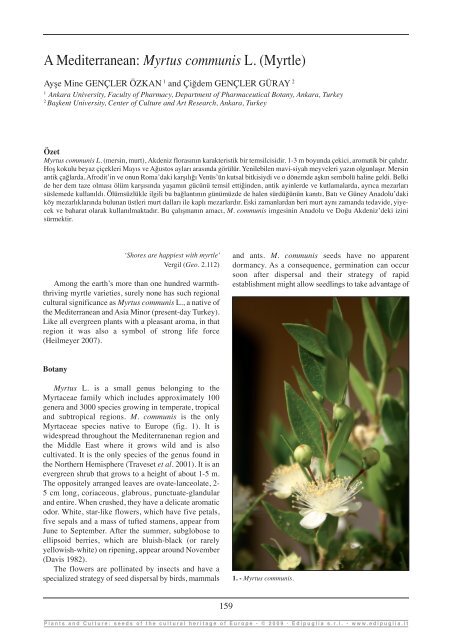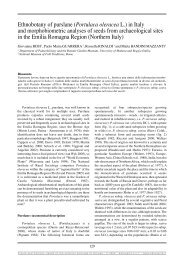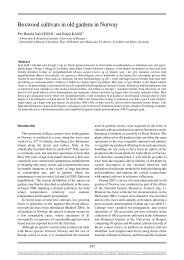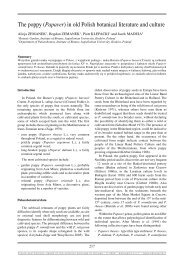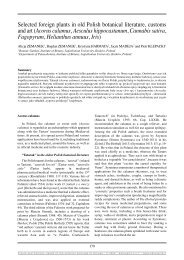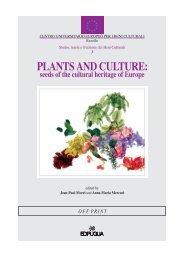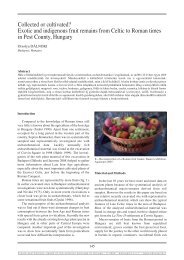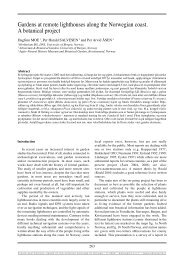Myrtus communis L. (Myrtle) - Plants and culture: seeds of the ...
Myrtus communis L. (Myrtle) - Plants and culture: seeds of the ...
Myrtus communis L. (Myrtle) - Plants and culture: seeds of the ...
Create successful ePaper yourself
Turn your PDF publications into a flip-book with our unique Google optimized e-Paper software.
A Mediterranean: <strong>Myrtus</strong> <strong>communis</strong> L. (<strong>Myrtle</strong>)<br />
Ayşe Mine GENÇLER ÖZKAN 1 <strong>and</strong> Çiğdem GENÇLER GÜRAY 2<br />
1 Ankara University, Faculty <strong>of</strong> Pharmacy, Department <strong>of</strong> Pharmaceutical Botany, Ankara, Turkey<br />
2 Başkent University, Center <strong>of</strong> Culture <strong>and</strong> Art Research, Ankara, Turkey<br />
Özet<br />
<strong>Myrtus</strong> <strong>communis</strong> L. (mersin, murt), Akdeniz florasının karakteristik bir temsilcisidir. 1-3 m boyunda çekici, aromatik bir çalıdır.<br />
Hoş kokulu beyaz çiçekleri Mayıs ve Ağustos ayları arasında görülür. Yenilebilen mavi-siyah meyveleri yazın olgunlaşır. Mersin<br />
antik çağlarda, Afrodit’in ve onun Roma’daki karşılığı Venüs’ün kutsal bitkisiydi ve o dönemde aşkın sembolü haline geldi. Belki<br />
de her dem taze olması ölüm karşısında yaşamın gücünü temsil ettiğinden, antik ayinlerde ve kutlamalarda, ayrıca mezarları<br />
süslemede kullanıldı. Ölümsüzlükle ilgili bu bağlantının günümüzde de halen sürdüğünün kanıtı, Batı ve Güney Anadolu’daki<br />
köy mezarlıklarında bulunan üstleri murt dalları ile kaplı mezarlardır. Eski zamanlardan beri murt aynı zam<strong>and</strong>a tedavide, yiyecek<br />
ve baharat olarak kullanılmaktadır. Bu çalışmanın amacı, M. <strong>communis</strong> imgesinin Anadolu ve Doğu Akdeniz’deki izini<br />
sürmektir.<br />
‘Shores are happiest with myrtle’<br />
Vergil (Geo. 2.112)<br />
Among <strong>the</strong> earth’s more than one hundred warmththriving<br />
myrtle varieties, surely none has such regional<br />
cultural significance as <strong>Myrtus</strong> <strong>communis</strong> L., a native <strong>of</strong><br />
<strong>the</strong> Mediterranean <strong>and</strong> Asia Minor (present-day Turkey).<br />
Like all evergreen plants with a pleasant aroma, in that<br />
region it was also a symbol <strong>of</strong> strong life force<br />
(Heilmeyer 2007).<br />
Botany<br />
<strong>Myrtus</strong> L. is a small genus belonging to <strong>the</strong><br />
Myrtaceae family which includes approximately 100<br />
genera <strong>and</strong> 3000 species growing in temperate, tropical<br />
<strong>and</strong> subtropical regions. M. <strong>communis</strong> is <strong>the</strong> only<br />
Myrtaceae species native to Europe (fig. 1). It is<br />
widespread throughout <strong>the</strong> Mediterranenan region <strong>and</strong><br />
<strong>the</strong> Middle East where it grows wild <strong>and</strong> is also<br />
cultivated. It is <strong>the</strong> only species <strong>of</strong> <strong>the</strong> genus found in<br />
<strong>the</strong> Nor<strong>the</strong>rn Hemisphere (Traveset et al. 2001). It is an<br />
evergreen shrub that grows to a height <strong>of</strong> about 1-5 m.<br />
The oppositely arranged leaves are ovate-lanceolate, 2-<br />
5 cm long, coriaceous, glabrous, punctuate-gl<strong>and</strong>ular<br />
<strong>and</strong> entire. When crushed, <strong>the</strong>y have a delicate aromatic<br />
odor. White, star-like flowers, which have five petals,<br />
five sepals <strong>and</strong> a mass <strong>of</strong> tufted stamens, appear from<br />
June to September. After <strong>the</strong> summer, subglobose to<br />
ellipsoid berries, which are bluish-black (or rarely<br />
yellowish-white) on ripening, appear around November<br />
(Davis 1982).<br />
The flowers are pollinated by insects <strong>and</strong> have a<br />
specialized strategy <strong>of</strong> seed dispersal by birds, mammals<br />
159<br />
<strong>and</strong> ants. M. <strong>communis</strong> <strong>seeds</strong> have no apparent<br />
dormancy. As a consequence, germination can occur<br />
soon after dispersal <strong>and</strong> <strong>the</strong>ir strategy <strong>of</strong> rapid<br />
establishment might allow seedlings to take advantage <strong>of</strong><br />
1. - <strong>Myrtus</strong> <strong>communis</strong>.<br />
<strong>Plants</strong> <strong>and</strong> Culture: <strong>seeds</strong> <strong>of</strong> <strong>the</strong> cultural heritage <strong>of</strong> Europe - © 2009 · Edipuglia s.r.l. - www.edipuglia.it
A MEDITERRANEAN: MYRTUS COMMUNIS L. (MYRTLE)<br />
autumn <strong>and</strong> winter rains during <strong>the</strong> crucial first stages<br />
<strong>of</strong> growth. These features can be considered<br />
advantageous in order to maximize reproductive<br />
success, with seedling establishment <strong>and</strong> survival in<br />
Mediterranean environments (Traveset et al. 2001;<br />
Aronne <strong>and</strong> De Micco 2004).<br />
Etymology 1<br />
<strong>Myrtle</strong> has closely associated names in most<br />
European <strong>and</strong> even some non-European languages;<br />
besides English myrtle, German myrte, Estonian mürt,<br />
Spanish <strong>and</strong> Italian mirto, French myrte, modern Greek<br />
mirtia [μυρτιά], Russian myrt [мырт], Armenian mrdeni<br />
[մրտենի] <strong>and</strong> Farsi mourd [دروہ] <strong>and</strong> Turkish murt.<br />
All <strong>the</strong>se names relate to <strong>the</strong> Old Greek myrtos<br />
[μύρτος] or myrsine [μυρσίνη] <strong>and</strong> were typically<br />
transmitted via Latin myrtus. The name derives from<br />
Greek myron [μύρον] meaning balm, chrism, ointment,<br />
which might be a Semitic loan <strong>and</strong> thus related to<br />
Hebrew mor [dm], myrrh (which is a reddish-brown<br />
resinous material, <strong>the</strong> dried sap <strong>of</strong> a number <strong>of</strong> trees, but<br />
primarily from Commiphora myrrha). Some o<strong>the</strong>r<br />
fragrant plants bear similar scientific names, e.g.<br />
Myristica (nutmeg), Myrrhis (cicely) or Myrica (gale).<br />
History<br />
<strong>Myrtle</strong>, as a typical shrub <strong>of</strong> <strong>the</strong> Mediterranean<br />
maquis, not only features in mythology, rituals <strong>and</strong><br />
ceremonies <strong>of</strong> ancient history but also has been an<br />
important plant <strong>of</strong> <strong>the</strong> daily life <strong>of</strong> <strong>the</strong> people <strong>of</strong> this<br />
region from time immemorial; as <strong>the</strong> Gilgamesh, known<br />
as <strong>the</strong> oldest written story on Earth, tells us beyond four<br />
to five millennia: «I <strong>of</strong>fered incence in front <strong>of</strong> <strong>the</strong><br />
Mountain-Ziggurat. Seven <strong>and</strong> seven cult vessels I put in<br />
place <strong>and</strong> (into <strong>the</strong> fire) underneath (or; into <strong>the</strong>ir bowls)<br />
I poured reeds, cedar <strong>and</strong> myrtle. The gods smelled <strong>the</strong><br />
savor <strong>and</strong> collected like flies over a (sheep) sacrifice»<br />
(Tablet XI, The Story <strong>of</strong> <strong>the</strong> Flood) (Kovacs 1989).<br />
Mediterranean Antiquity<br />
Mythology <strong>and</strong> Rituals<br />
In ancient mythology, myrtle was sacred to Aphrodite<br />
– Greek goddess <strong>of</strong> love, sex <strong>and</strong> beauty – <strong>and</strong> her<br />
Roman equivalent Venus, as it was to <strong>the</strong> Mesopotamian<br />
goddess Ishtar, hence it became <strong>the</strong> plant <strong>of</strong> love. With<br />
its evergreen leaves, elegant white flowers <strong>and</strong> pleasant<br />
perfume, it also symbolized beauty <strong>and</strong> youth. There is<br />
little information in <strong>the</strong> Greek literature before<br />
Plutarchus (Roman historian <strong>of</strong> Greek origin, AD 46-<br />
120) (Marcellus 22.4) connecting myrtle with Aphrodite,<br />
160<br />
but apparently <strong>the</strong>re were temples to Aphrodite where a<br />
sacred myrtle was cultivated (fig. 2). Aristophanes<br />
(Greek playwright, c. 450-c. 380 BC) uses “myrtle” as a<br />
euphemism for <strong>the</strong> female genitalia (Lysistrata 1004)<br />
(Staples 1998; Ferber 2007) Pausanias (Greek traveller<br />
<strong>and</strong> geographer <strong>of</strong> <strong>the</strong> 2 nd century AD) explains in his<br />
Description <strong>of</strong> Greece that presence <strong>of</strong> rose <strong>and</strong> myrtle<br />
in Aphrodite worship relates directly to <strong>the</strong> story <strong>of</strong><br />
Adonis (Pausanias, Elis 2, 7). The Graces, attendants <strong>of</strong><br />
Aphrodite, are also associated with myrtle (fig. 3). One<br />
<strong>of</strong> <strong>the</strong> Graces in <strong>the</strong> sanctuary at Elis (Greece) holds a<br />
myrtle branch (Pausanias, Elis 2-6).<br />
According to Ovidius (Roman poet, 43 BC - AD 17),<br />
a story has emerged <strong>of</strong> Venus rising from <strong>the</strong> sea at birth<br />
covered with myrtle, which <strong>of</strong>ten grows by <strong>the</strong> shore.<br />
Venus’ son Aeneas shades his temples with “maternal<br />
myrtle” (materna myrto) before <strong>the</strong> games (Aeneid 5.72)<br />
<strong>and</strong> later in <strong>the</strong> underworld he sees a myrtle grove where<br />
those who died <strong>of</strong> love w<strong>and</strong>er disconsolate (6.443)<br />
(Ferber 2007).<br />
An anecdote quoted by A<strong>the</strong>naeus (Ancient Greek<br />
author, c. AD 200) illustrates <strong>the</strong> link between Aphrodite<br />
<strong>and</strong> myrtle: Herostratos, a merchant plying <strong>the</strong> waters<br />
between Cyprus <strong>and</strong> Egypt, buffeted by a terrible storm,<br />
all aboard his ship prayed to Aphrodite to save <strong>the</strong>m.<br />
Fresh myrtle sprouted around <strong>the</strong> small statue <strong>of</strong> <strong>the</strong><br />
goddess, permeating <strong>the</strong> air with its sweet scent <strong>and</strong><br />
soothing <strong>the</strong> seasick men as <strong>the</strong> skies cleared. The crew<br />
safely arrived in Egypt <strong>and</strong> Herostratos was moved to a<br />
sanctuary to dedicate <strong>the</strong> image <strong>and</strong> to distribute crowns<br />
<strong>of</strong> <strong>the</strong> miraculous myrtle to her worshippers (Larson<br />
2007).<br />
Because Aphrodite was associated with it, myrtle<br />
took an important place in <strong>the</strong> Aphrodite rituals. <strong>Myrtle</strong><br />
crowns were distinctive features <strong>of</strong> her worship. Ovidius<br />
mentions three ritual prescriptions: first, <strong>the</strong> statue <strong>of</strong> <strong>the</strong><br />
goddess was to be stripped, washed <strong>and</strong> re-adorned;<br />
second, <strong>the</strong> women <strong>the</strong>mselves were to ba<strong>the</strong> under<br />
boughs <strong>of</strong> myrtle; <strong>and</strong> third, <strong>the</strong>y were to drink a ritual<br />
potion. Ovidius provided a myth to explain <strong>the</strong> necessity<br />
for bathing under <strong>the</strong> myrtle. Once, after a ba<strong>the</strong>, Venus<br />
used a myrtle bough to screen herself from <strong>the</strong> lewd gaze<br />
<strong>of</strong> satyrs (Larson 2007; Staples 1998).<br />
The scholium to line 330 <strong>of</strong> Frogs <strong>of</strong> Aristophanes<br />
lists <strong>the</strong> myrtle, in addition to <strong>the</strong> ivy <strong>and</strong> <strong>the</strong> vine, as <strong>the</strong><br />
third favorite plant <strong>of</strong> Dionysus, <strong>the</strong> god <strong>of</strong> wine. He was<br />
one <strong>of</strong> <strong>the</strong> very few that was able to bring a dead person<br />
out <strong>of</strong> <strong>the</strong> underworld. Even though he had never known<br />
his mo<strong>the</strong>r Semele, he journeyed into <strong>the</strong> underworld to<br />
carry away her from <strong>the</strong> dead. The underworld god,<br />
Hades, normally reluctant to release <strong>the</strong> dead, would<br />
have only agreed if Dionysus could have left something<br />
as important to life as a surrogate for Semele. So,<br />
Dionysus gave him <strong>the</strong> myrtle plant. This is <strong>the</strong> basis for<br />
<strong>the</strong> belief that myrtle belonged both to Dionysus <strong>and</strong> to<br />
<strong>Plants</strong> <strong>and</strong> Culture: <strong>seeds</strong> <strong>of</strong> <strong>the</strong> cultural heritage <strong>of</strong> Europe - © 2009 · Edipuglia s.r.l. - www.edipuglia.it
AYŞE MI˙NE GENÇLER ÖZKAN, ÇI˙ĞDEM GENÇLER GÜRAY<br />
2. - Aphrodite driving a chariot drawn by Erotes; attic red figure, c. 450-400 BC, Museo Archeologico<br />
Etrusco, Florence, Italy (www.<strong>the</strong>oi.com).<br />
3. - The younger Kharites Eudaimonia, seated holding a necklace, <strong>and</strong> P<strong>and</strong>aisia, carrying a<br />
myrtle; attic red figure, ca 450-400 BC, British Museum, London (www.<strong>the</strong>oi.com).<br />
<strong>the</strong> dead. Moreover, all evergreens like myrtle, box, ivy,<br />
laurel were Dionysiac plants, that is symbols <strong>of</strong><br />
generative power, signifying perpetuity <strong>of</strong> youth <strong>and</strong><br />
vigor. Every Dionysian worshipper wore a myrtle wreath<br />
in his rituals (Knight 1993; Otto <strong>and</strong> Palmer 1995;<br />
Grimal 1987).<br />
There is also a link between myrtle <strong>and</strong> <strong>the</strong> Bona Dea<br />
(<strong>the</strong> Good Goddess), a very old Roman deity <strong>of</strong> women,<br />
fertility, healing <strong>and</strong> virginity. Bona Dea worship was<br />
exclusively con fined to women. A festival to her was held<br />
at <strong>the</strong> start <strong>of</strong> May <strong>and</strong> not even male animals were<br />
161<br />
allowed to this celebration.<br />
<strong>Myrtle</strong> was also excluded from<br />
<strong>the</strong> cult because, as <strong>the</strong> mytho -<br />
logists relate, this goddess was<br />
<strong>the</strong> wife <strong>of</strong> <strong>the</strong> god Faunus <strong>and</strong>,<br />
after having been found out<br />
drinking wine in secret, was<br />
beaten to death by her husb<strong>and</strong><br />
with myrtle twigs. Both myrtle<br />
<strong>and</strong> wine were again mentioned<br />
in ano<strong>the</strong>r story: <strong>the</strong> goddess<br />
was <strong>the</strong> daughter <strong>of</strong> Faunus <strong>and</strong><br />
that she resisted <strong>the</strong> amorous<br />
advances <strong>of</strong> her fa<strong>the</strong>r who had<br />
fallen in love with her, so that he<br />
beat her death with myrtle twigs<br />
because she did not yield to his<br />
desires though she had been<br />
made drunk by him on wine. As<br />
a result myrtle was excluded<br />
from <strong>the</strong> rites altoge<strong>the</strong>r <strong>and</strong><br />
wine – as libation in her honour<br />
– was brought in a honey pot<br />
<strong>and</strong> cold milk. Plutarchus also<br />
surmised that <strong>the</strong> reason for <strong>the</strong><br />
exclusion <strong>of</strong> myrtle was<br />
because it was a plant sacred to<br />
Venus <strong>and</strong> Bona Dea was a<br />
chaste goddess (Brouwer 1989;<br />
Staples 1998).<br />
When a myrtle leaf is held<br />
up to <strong>the</strong> light it looks as though<br />
it has been pierced many times<br />
with a needle which are in fact<br />
<strong>the</strong> gl<strong>and</strong>s <strong>of</strong> volatile myrtleoil.<br />
A myth attributes <strong>the</strong>se to<br />
<strong>the</strong> unhappy Phaedra as told in<br />
<strong>the</strong> ancient tragedy Hippolytus,<br />
by <strong>the</strong> great Greek tragedian,<br />
Euripides (480-407/6 BC).<br />
Phaedra married King Theseus<br />
who had a son, Hippolytus,<br />
from a previous marriage to <strong>the</strong><br />
Amazonian queen Hippolyte.<br />
Because young Hippolytus an -<br />
gered Aphrodite by shunning her worship <strong>and</strong> devoting<br />
himself to Artemis – <strong>the</strong> virgin goddess <strong>of</strong> <strong>the</strong> hunt – to<br />
punish him Aphrodite compels Phaedra to begin lusting<br />
after her stepson. With her impossible <strong>and</strong> illicit passion,<br />
Phaedra used to recline idly all day long under <strong>the</strong> myrtle<br />
tree <strong>and</strong> used to pierce <strong>the</strong> myrtle leaves with her hairpin<br />
to avenge herself on Aphrodite because she had not<br />
granted her power over Hippolytus. Since he refused her<br />
<strong>and</strong> her passion for him became known, Phaedra hanged<br />
herself leaving a letter in which she charged her stepson<br />
<strong>of</strong> having assaulted her. Theseus proceeds to uncon -<br />
<strong>Plants</strong> <strong>and</strong> Culture: <strong>seeds</strong> <strong>of</strong> <strong>the</strong> cultural heritage <strong>of</strong> Europe - © 2009 · Edipuglia s.r.l. - www.edipuglia.it
A MEDITERRANEAN: MYRTUS COMMUNIS L. (MYRTLE)<br />
ditionally curse Hippolytus <strong>and</strong> calls upon <strong>the</strong> sea-god,<br />
Poseidon to destroy him (Baumann 1993; Berens 2007;<br />
Gregory 1997).<br />
The ancient Persians also regarded myrtle as a holy<br />
plant. Herodotus (Greek historian, c. 484- c. 420 BC) in<br />
his History narrates <strong>the</strong> Persian sacrifice ceremony in<br />
detail. He says: «The sacrificer brings his victim to a<br />
spot <strong>of</strong> ground <strong>and</strong> <strong>the</strong>n calls upon <strong>the</strong> name <strong>of</strong> <strong>the</strong> god<br />
to whom he intends to <strong>of</strong>fer. It is usual to have a turban<br />
encircled with a wreath, with commonly <strong>of</strong> myrtle»<br />
(Davis 1912).<br />
Daily life<br />
Theophrastus (Greek philosopher <strong>and</strong> natural<br />
scientist, c. 371- c. 288 BC) cites myrtle on some<br />
occasions. He refers (F81) to an old recommendation<br />
that olive <strong>and</strong> myrtle trees need hard pruning to promote<br />
growth <strong>and</strong> fruitfulness. The importance <strong>of</strong> pruning for<br />
fructification is emphasized. He also tells about (F82)<br />
<strong>the</strong> sympathy between olive <strong>and</strong> myrtle trees, which<br />
entwine <strong>the</strong>ir roots so <strong>the</strong> myrtle’s fruit becomes tender<br />
<strong>and</strong> sweet whilst <strong>the</strong> olive shelters it from sun <strong>and</strong> wind<br />
(Keyser <strong>and</strong> Irby-Massie 2008; Isager 1995).<br />
Theophrastus has also left us a description <strong>of</strong> <strong>the</strong><br />
woods <strong>of</strong> Latium as <strong>the</strong>y were in <strong>the</strong> fourth century<br />
before Christ. He says: «The l<strong>and</strong> <strong>of</strong> <strong>the</strong> Latins is all<br />
moist. The plains produce laurels, myrtles <strong>and</strong> wonderful<br />
beeches...» (Frazer 1922).<br />
Herodotus usually mentioned myrtle in connection<br />
with sacrifices <strong>and</strong> festal occasions: myrtle was strewn<br />
on <strong>the</strong> roads by <strong>the</strong> Persians to celebrate <strong>the</strong>ir capture <strong>of</strong><br />
A<strong>the</strong>ns (vii. 99, cf. 54) <strong>and</strong> myrtle boughs were used for<br />
drawing up pitch out <strong>of</strong> a pool in Zacynthus (iv 195)<br />
(Forster 1942).<br />
In A<strong>the</strong>ns, fragrant myrtle wreaths could be worn at<br />
sacrifices, banquets <strong>and</strong> weddings, <strong>and</strong> its berries were<br />
eaten as a dessert dish. <strong>Myrtle</strong>’s association with <strong>the</strong><br />
goddess Aphrodite is part <strong>of</strong> a pattern which connects<br />
<strong>the</strong> plant’s appealing scent with sexual desire. In <strong>the</strong><br />
Lysistrata, Aristophanes puts this notion vividly on stage<br />
when Myrrhina teases her husb<strong>and</strong> with <strong>the</strong> prospect <strong>of</strong><br />
sex (Lys. 889-953). Myrrhina is a conventional comic<br />
name derived from myrtle (Connors 1997).<br />
Wreaths <strong>of</strong> foliage, generally <strong>of</strong> laurel, olive, myrtle<br />
etc. appear upon coins, sometimes encircling symbolical<br />
figures <strong>and</strong> sometimes as chaplets on <strong>the</strong>ir heads<br />
signifying <strong>the</strong> perpetuity <strong>of</strong> existence. Hence <strong>the</strong> crowns<br />
<strong>of</strong> laurel, olive, myrtle etc., with which <strong>the</strong> victors in <strong>the</strong><br />
Roman triumphs <strong>and</strong> Greek games were honoured, may<br />
be considered as emblems <strong>of</strong> consecration to immortality<br />
<strong>and</strong> not as mere transitory marks <strong>of</strong> occasional<br />
distinction (Knight 1993). Plinius (ancient natural<br />
philosopher <strong>and</strong> author, AD 23-79) reports that a Roman<br />
comm<strong>and</strong>er was crowned with <strong>the</strong> myrtle <strong>of</strong> Venus<br />
162<br />
Victrix (Venus <strong>the</strong> Victorious) for a victory in which no<br />
one was slain (Natural History 15.38) (Ferber 2007).<br />
In A<strong>the</strong>ns, <strong>the</strong> pillars which stood in front <strong>of</strong> <strong>the</strong><br />
houses were decorated with branches <strong>of</strong> laurel or myrtle<br />
<strong>and</strong> received <strong>of</strong>ferings <strong>of</strong> incense or oil (Larson 2007).<br />
Pausanias (iii. 22) mentions certain colonists who were<br />
guided by a hare to a site where <strong>the</strong> animal hid in a<br />
myrtle bush. They <strong>the</strong>refore adore <strong>the</strong> myrtle (Lang<br />
2001).<br />
Both myrtle’s connection with festivals <strong>and</strong> its<br />
association with love, a common subject <strong>of</strong> song, may<br />
account for its use as a crown for poets, along with<br />
laurel, ivy or oak. A famous drinking song collected by<br />
A<strong>the</strong>naeus tells <strong>of</strong> <strong>the</strong> two liberators <strong>of</strong> A<strong>the</strong>ns: «In a<br />
myrtle bough will I carry <strong>the</strong> sword / Like Harmodious<br />
<strong>and</strong> Aristogiton / When <strong>the</strong>y killed <strong>the</strong> tyrant / <strong>and</strong><br />
brought equality to A<strong>the</strong>ns» (Deipnosophistae 15.565).<br />
It is hard to see how myrtle branches could have<br />
concealed swords, but myrtle doubtless adorned <strong>the</strong><br />
festival where <strong>the</strong> tyrant was killed <strong>and</strong> poetic point may<br />
lie in <strong>the</strong> contrast between <strong>the</strong> festive <strong>and</strong> friendly<br />
connotations <strong>of</strong> myrtle <strong>and</strong> <strong>the</strong> contrary sense <strong>of</strong> sword:<br />
<strong>Myrtle</strong> <strong>of</strong> love that defeats <strong>the</strong> tyranny <strong>and</strong> not <strong>the</strong> sword<br />
(Ferber 2007).<br />
A<strong>the</strong>naeus made <strong>the</strong> participants in <strong>the</strong> banquet<br />
described in his narrative Deipnosophistai wear myrtle<br />
crowns to combat drunkenness. Goldsmiths <strong>and</strong><br />
silversmiths modelled <strong>the</strong> myrtle with great skill in<br />
artistic objects. The gold myrtle wreath which was<br />
discovered in a royal tomb in 1977 at Vergina,<br />
Macedonia, is <strong>of</strong> remarkable beauty <strong>and</strong> possibly dated<br />
about 340 BC (Baumann 1993).<br />
Funeral rites<br />
<strong>Myrtle</strong> was also considered as a death tree. It has<br />
been used in funerary rites, toge<strong>the</strong>r with mint <strong>and</strong><br />
rosemary, to <strong>of</strong>fset <strong>the</strong> smell <strong>of</strong> decay by ancient Greeks<br />
<strong>and</strong> Romans (Graves 1955). The Electra <strong>of</strong> Euripides<br />
mentions myrtle several times related to <strong>the</strong> funeral rites:<br />
«Agamennon’s grave, dishonoured, has not yet ever<br />
received any libations, or branch <strong>of</strong> myrtle» (Line 320).<br />
«... I wept for its desolation; <strong>the</strong>n I opened <strong>the</strong> wine skin<br />
which I am bringing to <strong>the</strong> guests <strong>and</strong> pour libation <strong>and</strong><br />
set myrtle sprigs round <strong>the</strong> tomb» (Euripides 2007). The<br />
myrtle <strong>and</strong> many o<strong>the</strong>r emblems employed in funerals<br />
are all significant <strong>of</strong> life rising out <strong>of</strong> death <strong>and</strong> <strong>of</strong> <strong>the</strong><br />
equivocal condition <strong>of</strong> dying yet immortal man (fig. 4).<br />
Medicine<br />
There are ample references to myrtle in ancient<br />
Egyptian medical texts as a remedy for urinary<br />
disorders, pain, heartburn, swelling, stiffness <strong>of</strong> <strong>the</strong><br />
limbs, cough <strong>and</strong> to remove mucus from <strong>the</strong> chest.<br />
In Coptic medicine, <strong>the</strong> essential oil <strong>of</strong> myrtle was<br />
used in a prescription with fresh rue <strong>and</strong> a mineral<br />
<strong>Plants</strong> <strong>and</strong> Culture: <strong>seeds</strong> <strong>of</strong> <strong>the</strong> cultural heritage <strong>of</strong> Europe - © 2009 · Edipuglia s.r.l. - www.edipuglia.it
AYŞE MI˙NE GENÇLER ÖZKAN, ÇI˙ĞDEM GENÇLER GÜRAY<br />
4. - <strong>Myrtle</strong> wreaths on <strong>the</strong> steps <strong>of</strong> a tomb, white-ground lekythos, c. 440-430 BC, Staatliche Antikensammlungen, Munich (Dayagi-<br />
Mendels 1993).<br />
for a number <strong>of</strong> skin ailments (Ch 219) (Manniche<br />
1999).<br />
Soranus (a Greek physician from Ephesus, 1st-2nd<br />
century) mentions myrtle under <strong>the</strong> title <strong>of</strong><br />
contraceptions <strong>and</strong> recommends smearing <strong>the</strong> cervix<br />
with a paste <strong>of</strong> myrtle oil with white lead to block <strong>the</strong><br />
passage <strong>of</strong> sperm. <strong>Myrtle</strong> was known as an antifertility<br />
agent <strong>and</strong> it was also included in some oral con -<br />
traceptives suggested by Soranus: «<strong>Myrtle</strong>, wallflower<br />
(or stock), bitter lupines in equal quantities; mix with<br />
water <strong>and</strong> mold into pills <strong>the</strong> size <strong>of</strong> a bean» (Lefkowitz<br />
<strong>and</strong> Fant 1977; Riddle 1992).<br />
Galen <strong>of</strong> Pergamum (a Roman physician <strong>and</strong><br />
philosopher <strong>of</strong> Greek origin, AD 129-200) transmits<br />
<strong>the</strong> information about a powder (Flauius’ powder) for<br />
‘dysentery’: myrtle, roses, juniper berries, etc., taken<br />
with diluted wine. In some ancient preparations,<br />
myrtle wine was mentioned as a vehicle. For example,<br />
<strong>the</strong> physician Andromakhos notes in Galen CMLoc 9.5<br />
(13.296 K.) that he employed an enema containing<br />
minerals (lime, realgar, etc.), plus sour grapes <strong>and</strong><br />
papyrus ash, in myrtle wine. The Byzantine physician<br />
Aetios <strong>of</strong> Amida (city <strong>of</strong> Diyarbakır in modern<br />
163<br />
Turkey) from <strong>the</strong> 6th century records his opium-based<br />
pill for “blood-spitting” containing also frankincense,<br />
myrtle, saffron <strong>and</strong> roses, etc. (Keyser <strong>and</strong> Irby-Massie<br />
2008).<br />
In his book De Alimentorum Facultatibus – his major<br />
work on <strong>the</strong> dynamics <strong>and</strong> kinetics <strong>of</strong> various foods –<br />
Galen explains <strong>the</strong> features <strong>of</strong> <strong>the</strong> myrtle-berry: «Like<br />
<strong>the</strong> juniper berry, it is devoid <strong>of</strong> nutriment, but it has <strong>the</strong><br />
opposite property. For it is exceedingly astringent <strong>and</strong><br />
as a result is constipating. Never<strong>the</strong>less it is not cold in<br />
property in portion to its astringency, because not only<br />
has it astringency, but some pungency has also been<br />
mixed with it» (Powell 2003).<br />
Dioscorides (<strong>the</strong> Greek pharmacologist <strong>and</strong> botanist,<br />
born in Tarsus, modern Turkey, AD c. 40-90) makes a<br />
distinction between <strong>the</strong> usual bluish-black fruit <strong>and</strong> <strong>the</strong><br />
less pr<strong>of</strong>itable white one (1.55). He prescribes it to cure<br />
respiratory complaints, for <strong>the</strong> bites <strong>of</strong> poisonous spiders<br />
<strong>and</strong> scorpions <strong>and</strong> much else, including <strong>the</strong> juice <strong>of</strong> <strong>the</strong><br />
cooked berries mixed with wine for intestinal<br />
inflammation. <strong>Myrtle</strong> was also one <strong>of</strong> <strong>the</strong> plants that<br />
Dioscorides recommended for menstrual problems as a<br />
sitz bath but not superficially as an emmenagogue<br />
<strong>Plants</strong> <strong>and</strong> Culture: <strong>seeds</strong> <strong>of</strong> <strong>the</strong> cultural heritage <strong>of</strong> Europe - © 2009 · Edipuglia s.r.l. - www.edipuglia.it
A MEDITERRANEAN: MYRTUS COMMUNIS L. (MYRTLE)<br />
(Baumann 1993; Riddle 1992; Gun<strong>the</strong>r 1959). He also<br />
described <strong>the</strong> preparation <strong>of</strong> <strong>the</strong> oil, saying that <strong>the</strong><br />
leaves were steeped in olive oil so that <strong>the</strong> latter<br />
absorbed <strong>the</strong> fragrant oil contained in <strong>the</strong> leaves<br />
(Manniche 1999).<br />
Judaism, Christıanity <strong>and</strong> Islam<br />
<strong>Myrtle</strong> is a venerated tree a branch <strong>of</strong> which was used<br />
as an essential accompaniment in all religious functions<br />
(Philpot 2004). The myrtle is used by prophets to<br />
indicate a change on <strong>the</strong> face <strong>of</strong> <strong>the</strong> earth, when <strong>the</strong><br />
knowledge <strong>of</strong> <strong>the</strong> Lord shall cover <strong>the</strong> earth as <strong>the</strong> waters<br />
cover <strong>the</strong> sea. Thus Isaiah, when speaking <strong>of</strong> that blessed<br />
epoch, says: «Instead <strong>of</strong> <strong>the</strong> thorn shall come up <strong>the</strong> firtree;<br />
<strong>and</strong> instead <strong>of</strong> <strong>the</strong> brier shall come up with<br />
myrtle-tree; <strong>and</strong> it shall be to <strong>the</strong> Lord for a name, for<br />
an everlasting sign that shall not be cut <strong>of</strong>f» (Isa. lv. 19).<br />
Again, <strong>the</strong> Lord says by <strong>the</strong> prophet: «I will plant in<br />
wilderness <strong>the</strong> cedar, <strong>the</strong> shittah-tree <strong>and</strong> <strong>the</strong> myrtle <strong>and</strong><br />
<strong>the</strong> oil-tree» (Isa. xli. 19) (Balfour 1857).<br />
It has been stated that Hadasseh, <strong>the</strong> original name<br />
for Es<strong>the</strong>r (a Jewish queen <strong>of</strong> <strong>the</strong> Persian Empire who<br />
risked her life to save her people), is derived from <strong>the</strong><br />
Hebrew word Hadas, meaning myrtle. It has also been<br />
conjectured that Es<strong>the</strong>r is formed from <strong>the</strong> word as, an<br />
Arabic name for myrtle <strong>and</strong> from <strong>the</strong> Persian word<br />
setareh meaning star, since <strong>the</strong> myrtle blossom<br />
resembles a twinkling star. According to <strong>the</strong> Midrash,<br />
myrtle typifies Es<strong>the</strong>r: «<strong>Myrtle</strong> which spreads fragrance<br />
as Es<strong>the</strong>r spread grace; myrtle fades not in winter, but is<br />
fresh in winter». The Jews also employed <strong>the</strong> myrtle as<br />
an emblem <strong>of</strong> justice (Balfour 1857; Abrahams 2004).<br />
<strong>Myrtle</strong> has also become popular for <strong>the</strong> Sukkot, a<br />
Jewish festival <strong>of</strong> thanks giving for <strong>the</strong> autumn harvest<br />
as well as <strong>the</strong> commemoration <strong>of</strong> <strong>the</strong> departure from<br />
Egypt. Many Jews come to Sukkot morning services<br />
carrying a lulav <strong>and</strong> etrod, known collectively as <strong>the</strong><br />
“four species”. The etrog is a lemon-like fruit or citron.<br />
The lulav bundle contains different types <strong>of</strong> tree twigs:<br />
palm, myrtle <strong>and</strong> willow. Their use as ceremonial objects<br />
goes back to biblical times. Jewish scriptures instruct<br />
Israelites to take “<strong>the</strong> fruit <strong>of</strong> beautiful trees” along with<br />
«branches <strong>of</strong> palms, boughs <strong>of</strong> thick-tree foliage <strong>and</strong><br />
willows <strong>of</strong> <strong>the</strong> brook <strong>and</strong> rejoice in <strong>the</strong> presence <strong>of</strong> God<br />
for seven days». The “thick tree” is interpreted to be<br />
myrtle. It represents <strong>the</strong> thick thorny forests that <strong>the</strong><br />
Israelites encountered when <strong>the</strong>y returned to Israel.<br />
These mountainous forests were very difficult to<br />
penetrate. Though myrtle does not have <strong>the</strong> thorns <strong>of</strong> <strong>the</strong><br />
trees that <strong>the</strong> Israelites struggled with, myrtle has come<br />
to represent <strong>the</strong> “thick-tree” because it grows in dense<br />
bushes on mountains throughout many areas <strong>of</strong> Israel.<br />
Additionally, according to <strong>the</strong> Midrash Rabbah (30: 14),<br />
<strong>the</strong> four species represent different parts <strong>of</strong> <strong>the</strong> human<br />
body. The etrog resembles <strong>the</strong> heart, <strong>the</strong> palm branch<br />
164<br />
represents <strong>the</strong> spine, <strong>the</strong> myrtle has small leaves which<br />
are like eyes <strong>and</strong> <strong>the</strong> willow resembles <strong>the</strong> lips (Weber<br />
<strong>and</strong> Weber 1999; Terry 2000; King <strong>and</strong> Stager 2001).<br />
On <strong>the</strong> evening <strong>of</strong> <strong>the</strong> Sabbath, Jews remember <strong>the</strong><br />
lamps <strong>and</strong> incense <strong>of</strong> <strong>the</strong> Temple in Jerusalem, when<br />
blessings are made over <strong>the</strong> havdallah c<strong>and</strong>le <strong>and</strong> spice<br />
box. Different spices are used, but myrtle has been called<br />
“<strong>the</strong> quintessential fragrant plant <strong>of</strong> Israel” <strong>and</strong> is <strong>of</strong>ten<br />
preferred, when available. Indeed, <strong>the</strong> spice box is called<br />
hadas by many Ashkenazic <strong>and</strong> Sephardic Jews<br />
(Worwood 1998).<br />
In Christianity, myrtle was given as a sacred plant to<br />
<strong>the</strong> Virgin Mary, to symbolize purity <strong>and</strong> fertility.<br />
Crowning typifies purity also <strong>and</strong> at early Christian<br />
weddings <strong>the</strong> couple were crowned by <strong>the</strong> priest with<br />
garl<strong>and</strong>s <strong>of</strong> myrtle after he had blessed <strong>the</strong> marriage<br />
ceremony. The wearing <strong>of</strong> <strong>the</strong> crown on <strong>the</strong> head is<br />
derived from early Christian tradition (Webber <strong>and</strong> Cram<br />
2003; Folkard 1884).<br />
There is an interesting account for myrtle by an Arab<br />
writer, who died in 1034, «I once entered at night» he<br />
says «into <strong>the</strong> principal Christian Church. I found it all<br />
strewed with green branches <strong>of</strong> myrtle <strong>and</strong> planted with<br />
cypress trees...» (Haines 1889).<br />
There are many collections <strong>of</strong> traditional sayings <strong>of</strong><br />
<strong>the</strong> Prophet Mohamed on <strong>the</strong> subject <strong>of</strong> medicine. In a<br />
translation <strong>of</strong> one such compilation, Tibb-ul-Nabbi<br />
(Medicine <strong>of</strong> Prophet), said to <strong>the</strong> Prophet: «If anyone<br />
<strong>of</strong>fers you myrtle as a present, do not refuse it. It is from<br />
<strong>the</strong> Heaven». This plant is also held in high esteem by<br />
Said Ibn ‘Abbas: «When <strong>the</strong> Prophet Noah descended<br />
from <strong>the</strong> Ark, <strong>the</strong> first thing that he planted was myrtle».<br />
And again from <strong>the</strong> same author: «Adam departed from<br />
paradise with myrtle, which is <strong>the</strong> queen <strong>of</strong> all<br />
sweetsmelling bushes in <strong>the</strong> world, toge<strong>the</strong>r with dates<br />
<strong>and</strong> corn». <strong>Myrtle</strong> was also mentioned several times in<br />
this same work as a medicinal plant: «The treatment <strong>of</strong><br />
a sprain also involves a streng<strong>the</strong>ning <strong>of</strong> <strong>the</strong> site by an<br />
oinment made from leaves <strong>of</strong> sesame <strong>and</strong> myrtle mixed<br />
toge<strong>the</strong>r in a dish»; «An infusion <strong>of</strong> myrtle benefits<br />
burns. A syrup is also made, but it is no use drinking it<br />
against a cough or to cut diarrhoea unless you also take<br />
quince with it. From <strong>the</strong> <strong>seeds</strong> <strong>of</strong> myrtle an elixir is<br />
made» (Elgood 1962).<br />
<strong>Myrtle</strong> in Anatolian-Turkish tradition<br />
The famous Ottoman traveler Evliya Celebi (1611-<br />
1682), who journeyed throughout <strong>the</strong> Ottoman Empire<br />
<strong>and</strong> neighbouring l<strong>and</strong>s over a period <strong>of</strong> forty years, had<br />
showed a particular interest to forests <strong>and</strong> trees <strong>and</strong><br />
mentioned <strong>the</strong> glorious hills <strong>and</strong> creeks <strong>of</strong> <strong>the</strong> Aegean<br />
region adorned with myrtle <strong>and</strong> bay tree. French<br />
naturalist Pierre Belon (1517-1564), who was <strong>the</strong> first<br />
European to enlist Anatolian native plants, also men -<br />
<strong>Plants</strong> <strong>and</strong> Culture: <strong>seeds</strong> <strong>of</strong> <strong>the</strong> cultural heritage <strong>of</strong> Europe - © 2009 · Edipuglia s.r.l. - www.edipuglia.it
AYŞE MI˙NE GENÇLER ÖZKAN, ÇI˙ĞDEM GENÇLER GÜRAY<br />
tioned <strong>the</strong> myrtle bushes with white berries growing<br />
along <strong>the</strong> Mediterranean coast <strong>of</strong> Anatolia (Baytop 2004).<br />
In accordance with <strong>the</strong> observations above, in Turkey<br />
<strong>the</strong> myrtle shrubs grow wildly in <strong>the</strong> rocky slopes, Pinus<br />
brutia forests, macchies, coastal s<strong>and</strong> dunes regions, just<br />
above sea level to 550 m. (especially in <strong>the</strong> West <strong>and</strong><br />
South). <strong>Myrtle</strong> is known in Turkish as “mersin”, “murt”,<br />
“hambeles”, “bahar”, “elduran” <strong>and</strong> “sazak” (Baytop<br />
1997, 1999). Its fruits are sold in <strong>the</strong> Aegean <strong>and</strong><br />
Mediterranean town markets such as Bodrum, Milas in<br />
Muğla (a province covering <strong>the</strong> South-Western corner<br />
<strong>of</strong> Turkey) (Ertuğ 2004a).<br />
During many periods <strong>of</strong> history, Anatolia served as a<br />
melting pot for different civilizations <strong>and</strong> many <strong>of</strong> <strong>the</strong><br />
present-day customs had <strong>the</strong>ir roots in <strong>the</strong> religious<br />
beliefs <strong>of</strong> <strong>the</strong> early <strong>culture</strong>s. The myrtle’s prominent<br />
place in funeral rites in <strong>the</strong> coastal regions <strong>of</strong> Turkey<br />
corroborates this link: myrtle is frequently used to<br />
perfume <strong>the</strong> water used to respectfully wash <strong>the</strong><br />
deceased. In some villages <strong>of</strong> Milas, <strong>the</strong> shrouded body<br />
is placed on myrtle twigs which cover <strong>the</strong> bottom <strong>of</strong> <strong>the</strong><br />
grave before <strong>the</strong> burial. In <strong>the</strong> same region, <strong>the</strong> common<br />
saying “to be in <strong>the</strong> embrace <strong>of</strong> myrtle” is used for a man<br />
who is at death’s door. A more common tradition – as<br />
also witnessed by <strong>the</strong> authors <strong>of</strong> this article – in<br />
Bozburun in Marmaris (in Western Anatolia) <strong>and</strong> in<br />
Çıralı in Antalya (in Sou<strong>the</strong>rn Anatolia), is for people to<br />
visit <strong>the</strong> graves <strong>and</strong> deck <strong>the</strong>m with myrtle twigs on<br />
religious holidays (fig. 5). This is a common ritual in<br />
most <strong>of</strong> <strong>the</strong> Aegean, including towns such as Buldan in<br />
inner west Anatolia, where myrtus does not naturally<br />
grow (Ertuğ et al. 2004). According to local belief,<br />
myrtle shares <strong>and</strong> reduces <strong>the</strong> torments <strong>of</strong> <strong>the</strong> deceased<br />
in <strong>the</strong> grave <strong>and</strong> proclaims a blessing (Salawat) on <strong>the</strong><br />
beloved Prophet (Çıblak 2002; Avcı 2003; Selçuk 2004;<br />
Çınar 2007). Dafni et al. also observed that myrtle is<br />
commonly planted in Muslim graveyards in Nor<strong>the</strong>rn<br />
Israel, but only in one village young shoots are placed<br />
directly on <strong>the</strong> graves (Dafni et al. 2006). The funeral<br />
symbolism <strong>of</strong> this plant can be traced back to <strong>the</strong> original<br />
myths <strong>of</strong> Anatolia mentioned previously in this article.<br />
In Turkish folk medicine, <strong>the</strong> leaves, fruits <strong>and</strong><br />
volatile oil <strong>of</strong> <strong>Myrtus</strong> <strong>communis</strong> have been used for<br />
several purposes: <strong>the</strong> leaves are used to treat<br />
hypertension, hemorrhoids, common colds, cardiac<br />
disorders, urethral disorders, diarrhoea, internal diseases,<br />
rheumatic pain, edema in <strong>the</strong> extremities, to lower blood<br />
glucose, to pass kidney stones, as an appetite stimulant,<br />
hair restorer, wound healer <strong>and</strong> a haemostatic. The<br />
volatile oil (Myrtii Oleum) prepared from <strong>the</strong> leaves by<br />
steam distillation is also commonly used to lower blood<br />
glucose. The fruits are traditionally used for coughs <strong>and</strong><br />
pneumonia, stomach disorders, kidney problems, thirst,<br />
vomiting, hair care, diarrhoea <strong>and</strong> hemorrhoids. The root<br />
is also used to treat hemorrhoids (Tuzlacı 2006; Baytop<br />
165<br />
5. - Bozburun (Marmaris-Muğla, Turkey) village cemetery; tombs<br />
decked with myrtle branches.<br />
1999; Yeşilada et al. 1995; Ertuğ 2004b). Ano<strong>the</strong>r<br />
interesting application is recorded in Buldan, where <strong>the</strong><br />
dried leaves <strong>of</strong> myrtle is pounded to powder <strong>and</strong> mixed<br />
with salt. This mixture is applied to <strong>the</strong> naked body <strong>of</strong><br />
new born babies when <strong>the</strong>y are a few days old, after half<br />
an hour <strong>the</strong> baby is ba<strong>the</strong>d. A similar application is made<br />
only with salt in o<strong>the</strong>r areas, to prevent <strong>the</strong> bad odor<br />
(Ertuğ et al. 2004).<br />
Its buds <strong>and</strong> fruits have been used as spices since<br />
ancient times in Anatolia. A fragrant distilled water is<br />
prepared from its leaves <strong>and</strong> flowers to aromatize fruit<br />
juices (Baytop 1999).<br />
The leaves <strong>and</strong> fruits <strong>of</strong> myrtle are used to dye wool<br />
fibers for weaving carpets <strong>and</strong> rugs in several areas <strong>of</strong><br />
Anatolia. Dried leaves are boiled in water, wool yarns<br />
are added to <strong>the</strong> coloured water with a mordant<br />
substance <strong>and</strong> after a few hours <strong>the</strong> colour <strong>of</strong> <strong>the</strong> yarns<br />
becomes mustard yellow. The fruits give a characteristic<br />
dark brown colour (Yılmaz <strong>and</strong> Karakuş 1991; Doğan<br />
et al. 2003).<br />
The boughs <strong>of</strong> myrtle are used to make garden arbors<br />
in <strong>the</strong> hot, dry summers <strong>of</strong> <strong>the</strong> Mediterranean region <strong>of</strong><br />
Anatolia. These arbors are called “talvar” or “hayma”<br />
locally. The plant is also preferred for decoration at<br />
traditional wedding ceremonies. The bark <strong>and</strong> root are<br />
used, toge<strong>the</strong>r with <strong>the</strong> oak gall, for tanning Turkish<br />
lea<strong>the</strong>r, to which <strong>the</strong>y add a peculiar odour. The leaves<br />
are also used to dress <strong>the</strong> skin (Baytop 1999).<br />
Although it is known that both <strong>the</strong> berries <strong>and</strong> <strong>the</strong><br />
leaves are used to macerate an aromatic liqueur called<br />
Mirto at <strong>the</strong> isl<strong>and</strong>s <strong>of</strong> Sardinia <strong>and</strong> Corsica (Guarrera et<br />
al. 2006), a beverage use is not practiced in Anatolia.<br />
Conclusion<br />
Botany scientists may <strong>of</strong>ten feel that plants are not<br />
yet explainable as biochemical machines <strong>and</strong> that <strong>the</strong>y<br />
have properties greater in value than <strong>the</strong> sum <strong>of</strong> <strong>the</strong>ir<br />
<strong>Plants</strong> <strong>and</strong> Culture: <strong>seeds</strong> <strong>of</strong> <strong>the</strong> cultural heritage <strong>of</strong> Europe - © 2009 · Edipuglia s.r.l. - www.edipuglia.it
A MEDITERRANEAN: MYRTUS COMMUNIS L. (MYRTLE)<br />
parts (Battey 2002). So, it is not surprising that our<br />
ancestors projected human <strong>and</strong> transcendental properties<br />
into plants (K<strong>and</strong>eler <strong>and</strong> Ullrich 2009). The purpose <strong>of</strong><br />
this review was to fully investigate <strong>the</strong> cultural <strong>and</strong><br />
traditional aspects <strong>of</strong> <strong>Myrtus</strong> <strong>communis</strong> that hide behind<br />
<strong>the</strong> symbolism ascribed to it along <strong>the</strong> ages.<br />
Throughout <strong>the</strong> history, <strong>the</strong> combination <strong>of</strong> <strong>the</strong><br />
myrtle flower’s attractive appearance, its edible berries,<br />
its sweet smell <strong>and</strong> its medicinal traits would have made<br />
<strong>the</strong> plant very appealing to <strong>the</strong> people living where this<br />
species could be found. In this respect, it is not difficult<br />
to imagine that an early relationship developed between<br />
man <strong>and</strong> this multi-purpose plant. In support <strong>of</strong> this<br />
argument, <strong>the</strong> authors have cited evidence from ancient<br />
mythology, authors <strong>of</strong> ancient times, religious stories,<br />
folk-lore <strong>and</strong> traditions originating especially from Asia<br />
Minor <strong>and</strong> <strong>the</strong> Eastern Mediterranean basin. The authors<br />
have also attempted to determine <strong>the</strong> natural <strong>and</strong> cultural<br />
origins <strong>of</strong> myrtle <strong>and</strong> to correctly identify <strong>the</strong> gaps <strong>the</strong><br />
extent data. Since ancient times, many key plants were<br />
used in connection with graves <strong>and</strong> sanctuaries.<br />
Today, some <strong>of</strong> <strong>the</strong> same symbolic plants <strong>and</strong> <strong>the</strong>ir<br />
secondary metabolites are being tested scientifically in<br />
order to feed future research in medicine <strong>and</strong> in<br />
biological plant protection (K<strong>and</strong>eler <strong>and</strong> Ullrich<br />
2009). Results have showed that myrtle is one <strong>of</strong> <strong>the</strong><br />
oldest medicinal plants to have been applied as<br />
antiseptic, anti-inflammatory <strong>and</strong> hypoglycaemic agent<br />
in a continuous chain <strong>of</strong> traditions. However, <strong>the</strong>re are<br />
few scientific reports about biological or<br />
pharmacological properties <strong>of</strong> myrtle <strong>and</strong> its extracts.<br />
For example, extracts <strong>and</strong> some isolated compounds <strong>of</strong><br />
this plant have been reported to be efficient as<br />
antibacterial, antifungal, antioxidant <strong>and</strong><br />
hypoglycaemic agents by some publishable studies,<br />
however more work is needed for <strong>Myrtus</strong> <strong>communis</strong><br />
(Mansouri et al. 2001; Sacchetti et al. 2007; Yoshimura<br />
et al. 2008; Sepici et al. 2004).<br />
<strong>Plants</strong> have played important roles in <strong>the</strong> oral<br />
traditions <strong>and</strong> <strong>the</strong> recorded myths <strong>of</strong> peoples worldwide,<br />
both ancient <strong>and</strong> modern. These roles are concerned with<br />
a variety <strong>of</strong> relationships. In this sense, every scientific<br />
approach to <strong>the</strong> plant kingdom must realize that<br />
«mythologic philosophies always antedate scientific<br />
philosophies». Because, as Dawkins (1998) pointed out,<br />
both myth-making <strong>and</strong> <strong>the</strong> reasoning ability <strong>of</strong> <strong>the</strong><br />
human being, originate from <strong>the</strong> fruitful power <strong>of</strong> an<br />
imaginative stream which irrigates <strong>the</strong> intellect.<br />
Notes<br />
1 Resources for <strong>the</strong> etymological information (Connection<br />
date: March 19, 2009) http://www.uni-graz.at/~katzer/ engl/<br />
Myrt_com.html; http://www.unigraz.at/~katzer/engl/ Myri_fra.<br />
html, http://en.wikipedia.org/wiki/Myrrh).<br />
166<br />
References<br />
Abrahams 2004: I. Abrahams - Festival Studies Being<br />
Thoughts on <strong>the</strong> Jewish Year, Kessinger Publishing,<br />
LLC, 2004.<br />
Aronne <strong>and</strong> De Micco 2004: G. Aronne <strong>and</strong> V. De Micco<br />
- Hypocotyl features <strong>of</strong> <strong>Myrtus</strong> <strong>communis</strong> (Myrtaceae):<br />
a many-sided strategy for possible enhancement <strong>of</strong><br />
seedling establisment in <strong>the</strong> Mediterranean<br />
environment, in Botanical Journal <strong>of</strong> Linnean Society,<br />
145, 2004, p. 195-202.<br />
Avcı 2003: A. Avcı - Halk Bilimi Araştırmaları, Turna<br />
Yayınları, 2003.<br />
Balfour 1857: J.H. Balfour - The <strong>Plants</strong> <strong>of</strong> Bible: Trees <strong>and</strong><br />
Shrubs, Edinburgh, T. Nelson <strong>and</strong> Sons, Paternoster<br />
Row, 1857.<br />
Battey 2002: N.H. Battey - Plant Culture: Thirteen<br />
Seasonal Pieces. Introduction, in Journal <strong>of</strong><br />
Experimental Botany, 53, 2002, p. 2289-2291.<br />
Baumann 1993: H. Baumann - The Greek Plant World: In<br />
Myth, Art <strong>and</strong> Literature, Timber Press, Portl<strong>and</strong>,<br />
Oregon, United States, 1993.<br />
Baytop 1997: T. Baytop - A Dictionary <strong>of</strong> Vernacular<br />
Names <strong>of</strong> Wild <strong>Plants</strong> <strong>of</strong> Turkey [in Turkish], Ankara,<br />
1997 (Publication <strong>of</strong> Turkish Language Society, No.<br />
578).<br />
Baytop 1999: T. Baytop - Therapy with Medicinal <strong>Plants</strong><br />
in Turkey: Past <strong>and</strong> Present [in Turkish], İstanbul,<br />
Nobel Publications, 1999.<br />
Baytop 2004: A. Baytop - The History <strong>of</strong> Botanical<br />
Researches in Turkey [in Turkish], Ankara, TUBITAK<br />
Publications, Yenigün Matbaası, 2004 (Academical<br />
Serial, No. 3).<br />
Berens 2007: E.M. Berens - Myths <strong>and</strong> Legends <strong>of</strong> Ancient<br />
Greece <strong>and</strong> Rome, Maynard, Merrill & Co. E-book,<br />
2007 (www.gutenberg.org).<br />
Brouwer 1989: H.H.J. Brouwer - Bona Dea: The Sources<br />
<strong>and</strong> a Description <strong>of</strong> <strong>the</strong> Cult, Bucks, Engl<strong>and</strong>, Brill<br />
Books, 1989.<br />
Connors 1997: C. Connors - Scents <strong>and</strong> Sensibility in<br />
Plautus’ Casina, in The Classical Quaterly, New Series,<br />
Vol. 47, No. 1, 1997.<br />
Çıblak 2002: N. Çıblak - Anadolu’da Ölüm Sonrası<br />
Mezarlıklar Çevresinde Oluşan İnanç ve Pratikler, in<br />
Türk Kültürü Y. XL., S.474, ss. 605-614, 2002.<br />
Çınar 2007: A.A. Çınar - Muğla ve Çevresi Sözlü Kültürü<br />
ve Toplumsal Değerleri, Muğla Belediyesi Yayınları,<br />
2007.<br />
Dafni et al. 2006: A. Dafni, E. Lev, S. Beckmann <strong>and</strong> C.<br />
Eichberger - Ritual <strong>Plants</strong> <strong>of</strong> Muslim Graveyards in<br />
Nor<strong>the</strong>rn Israel in Journal <strong>of</strong> Ethnobiology <strong>and</strong><br />
Ethnomedicine, 2, 38, 2006 (Published online on<br />
September 2006, www.ethnobiomed.com/content/<br />
pdf/1746-4269-2-38.pdf).<br />
Davis 1912: W.S. Davis (Ed.) - Histories by Herodotus,<br />
transl. by G. Rawlinson, in Readings in Ancient History,<br />
Volume 1, Boston, Allyn <strong>and</strong> Bacon, 1912.<br />
Davis 1982: P.H. Davis - Myrtaceae, in Flora <strong>of</strong> Turkey<br />
<strong>Plants</strong> <strong>and</strong> Culture: <strong>seeds</strong> <strong>of</strong> <strong>the</strong> cultural heritage <strong>of</strong> Europe - © 2009 · Edipuglia s.r.l. - www.edipuglia.it
AYŞE MI˙NE GENÇLER ÖZKAN, ÇI˙ĞDEM GENÇLER GÜRAY<br />
<strong>and</strong> <strong>the</strong> East Aegean Isl<strong>and</strong>s, Vol. 4, Edinburgh, <strong>the</strong><br />
University Press, 1982.<br />
Dawkins 1998: R. Dawkins - Unweaving <strong>the</strong> Rainbow.<br />
Science, Delusion <strong>and</strong> <strong>the</strong> Appetite for Wonder, Boston,<br />
New York, Houghton Mifflin Co., 1998.<br />
Dayagi-Mendels 1993: M. Dayagi-Mendels - Perfumes<br />
<strong>and</strong> Cosmetics in <strong>the</strong> Ancient World, Tel Aviv, The Israel<br />
Museum Jerusalem, Sabinsky Press Ltd., 1993.<br />
Doğan et al. 2003: Y. Doğan, S. Başlar, H.H. Mert <strong>and</strong> G.<br />
Ay - <strong>Plants</strong> Used as Naturel Dye Sources in Turkey [in<br />
Turkish], in Economic Botany, 57(4), 2003, p. 442-453.<br />
Elgood 1962: C. Elgood - Tibb-ul Nabbi or Medicine Of<br />
<strong>the</strong> Prophet, in Osiris, Vol. 14, 1962, p. 33-192.<br />
Ertuğ 2004a : F. Ertuğ - Wild Edible <strong>Plants</strong> <strong>of</strong> <strong>the</strong> Bodrum<br />
Area (Muğla, Turkey), in Turkish Journal <strong>of</strong> Botany 28,<br />
p. 161-174 (http://journals.tubitak.gov.tr/botany/issues/<br />
bot-04-28-1-2/bot-28-1-2-16-0210-17.pdf).<br />
Ertuğ 2004b : F. Ertuğ - Bodrum Yöresinde Halk Tıbbında<br />
Yararlanılan Bitkiler [Medicinal plants used in <strong>the</strong> folk<br />
medicine <strong>of</strong> Bodrum area], in K.H.C. Başer <strong>and</strong> N.<br />
Kırımer (Eds.) - 14. Bitkisel İlaç Hammaddesi<br />
Toplantısı, Bildiriler, 29-31 Mayıs 2002, Eskişehir, ebook:<br />
http://documents.anadolu.edu.tr/bihat.<br />
Ertuğ et al 2004: F. Ertuğ, G. Tümen, A. Çelik <strong>and</strong> T.<br />
Dirmenci - TÜBA-TÜKSEK Buldan (Denizli)<br />
Etnobotanik Alan Araştırma Raporu 2003 Yılı<br />
Çalışması [Buldan Ethnobotanical Study 2003 report],<br />
in Türkiye Bilimler Akademisi TÜBA Kültür Envanteri<br />
Dergisi, 2, p. 187-218.<br />
Euripides 2007: Euripides - Electra, transl. by E.P.<br />
Coleridge, Raleigh, North Carolina, Hayes Barton<br />
Press, 2007.<br />
Ferber 2007: M. Ferber - Dictionary <strong>of</strong> Literary Symbols,<br />
Second Edition, Cambridge, Cambridge University<br />
Press, 2007.<br />
Folkard 1884: R. Folkard - Plant Lore, Legends <strong>and</strong><br />
Lyrics: Embracing <strong>the</strong> Myths, Traditions, Superstitions,<br />
<strong>and</strong> Folk-lore <strong>of</strong> The Plant Kingdom, London, S. Low,<br />
Marston, Searle <strong>and</strong> Rivington, 1884.<br />
Forster 1942: E.S. Forster - Trees <strong>and</strong> <strong>Plants</strong> in Herodotus,<br />
in The Classical Review, Vol. 56, No. 2, June 1942, p.<br />
57-63.<br />
Frazer 1922: J.G. Frazer - The Golden Bough, New York,<br />
Mac Millan, 1922.<br />
Graves 1955: R. Graves - The Greek Myths (Volume I),<br />
Penguin Books, 1955.<br />
Gregory 1997: J. Gregory - Euripides <strong>and</strong> <strong>the</strong> Instruction<br />
<strong>of</strong> <strong>the</strong> A<strong>the</strong>nians, Ann Arbor, University <strong>of</strong> Michigan<br />
Press, 1997.<br />
Grimal 1987: P. Grimal - The Dictionary <strong>of</strong> Classical<br />
Mythology, Oxford, Blackwell, 1987.<br />
Guarrera et al. 2006: P.M. Guarrera, G. Salerno <strong>and</strong> G.<br />
Caneva - Food, Flavoring <strong>and</strong> Feed Plant Traditions in<br />
<strong>the</strong> Tyrrhenian Sector <strong>of</strong> Basilicata, Italy, in Journal <strong>of</strong><br />
Ethnobiology <strong>and</strong> Ethnomedicine, 2, 2006, p. 37.<br />
Gun<strong>the</strong>r 1959: R.T. Gun<strong>the</strong>r (Ed.) - The Greek Herbal <strong>of</strong><br />
Dioscorides, New York, Hafner Publishing Co., 1959.<br />
Haines 1889: C.R. Haines - Christianity <strong>and</strong> Islam in<br />
167<br />
Spain, AD 756- 1031, London, Kegan Paul, Trench &<br />
Co., 1889.<br />
Heilmeyer 2007: M. Heilmeyer - <strong>Myrtle</strong>, in Ancient Herbs,<br />
Getty Publications, 2007.<br />
Isager 1995: S. Isager - Ancient Greek Agri<strong>culture</strong>: An<br />
Introduction, Florence, KY, Routledge, 1995.<br />
K<strong>and</strong>eler <strong>and</strong> Ullrich 2009: R. K<strong>and</strong>eler <strong>and</strong> W.R. Ullrich<br />
- Symbolism <strong>of</strong> <strong>Plants</strong>: Examples <strong>of</strong> European-<br />
Mediterranean Culture Presented with Biology <strong>and</strong><br />
History <strong>of</strong> Art, in Journal <strong>of</strong> Experimental Botany, Vol.<br />
60, No.1, 2009, p. 5-6.<br />
Keyser <strong>and</strong> Irby-Massie 2008: P.T. Keyser <strong>and</strong> G.L.<br />
Irby-Massie (Eds.) - The Encyclopedia <strong>of</strong> Ancient<br />
Natural Scientists: The Greek Traditions <strong>and</strong> Its Many<br />
Heirs, New York, Routledge, Taylor <strong>and</strong> Francis<br />
Group, 2008.<br />
King <strong>and</strong> Stager 2001: P.J. King <strong>and</strong> L.E. Stager - Life in<br />
Biblical Israel, London, Westminster John Knox, 2001.<br />
Knight 1851: C. Knight - Penny Cyclopedia <strong>of</strong> <strong>the</strong> Society<br />
for <strong>the</strong> Diffusion <strong>of</strong> Useful Knowledge, London, 1851.<br />
Knight 1993: R.P. Knight - The Symbolical Language <strong>of</strong><br />
Ancient Art <strong>and</strong> Mythology, Whitefish, MT, Kessinger<br />
Publishing, 1993, p. 32.<br />
Kovacs 1989: M.G. Kovacs (Transl.) - The Epic <strong>of</strong><br />
Gilgamesh, Stanford University Press, 1989.<br />
Lang 2001: A. Lang - Myth, Ritual <strong>and</strong> Religion, Project<br />
Gutenberg IL, 2001.<br />
Larson 2007: J.L. Larson - Ancient Greek Cults: A Guide,<br />
New York, Routledge (Taylor <strong>and</strong> Francis Group),<br />
2007.<br />
Lefkowitz <strong>and</strong> Fant 1977: M.R. Lefkowitz <strong>and</strong> M.B. Fant<br />
- Women in Greece <strong>and</strong> Rome, Toronto, Samuel-<br />
Stevens, 1977.<br />
Manniche 1999: L. Manniche - An Ancient Egyptian<br />
Herbal, Austin, University <strong>of</strong> Texas Press, 1999.<br />
Mansouri et al. 2001: S. Mansouri, A. Foroumadi, T.<br />
Ghaneie <strong>and</strong> A.G. Najar - Antibacterial Activity <strong>of</strong> <strong>the</strong><br />
Crude Extracts <strong>and</strong> Fractionated Constituents <strong>of</strong><br />
<strong>Myrtus</strong> <strong>communis</strong>, in Pharmaceutical Biology, Vol. 39,<br />
No. 5, 2001, p. 399-401.<br />
Otto <strong>and</strong> Palmer 1995: W.F. Otto <strong>and</strong> R.B. Palmer -<br />
Dionysus: Myth <strong>and</strong> Cult, Indiana University Press,<br />
1995.<br />
Pausanias 1913: Pausanias - Pausanias’s Description <strong>of</strong><br />
Greece 3: Commentary on Book II - V, transl. by J.G.<br />
Frazer, London, MacMillan, 1913.<br />
Philpot 2004: J.H. Philpot - The Sacred Tree in Religion<br />
<strong>and</strong> Myth, New York, Courier Dover Publications,<br />
2004.<br />
Powell 2003: O. Powell (Ed.) - Galen: On <strong>the</strong> Properties<br />
<strong>of</strong> Foodstuffs, West Nyack, NY, Cambridge University<br />
Press, 2003.<br />
Riddle 1992: J.M. Riddle - Contraception <strong>and</strong> Abortion<br />
from <strong>the</strong> Ancient World to Renaissance, Harvard<br />
University Press, 1992.<br />
Sacchetti et al. 2007: G. Sacchetti, M. Muzzoli, G.A. Statti,<br />
F. Conforti, A. Bianchi, C. Agrimonti, M. Ballero <strong>and</strong> F.<br />
Poli - Intra-specific Biodiversity <strong>of</strong> Italian <strong>Myrtle</strong> (<strong>Myrtus</strong><br />
<strong>Plants</strong> <strong>and</strong> Culture: <strong>seeds</strong> <strong>of</strong> <strong>the</strong> cultural heritage <strong>of</strong> Europe - © 2009 · Edipuglia s.r.l. - www.edipuglia.it
A MEDITERRANEAN: MYRTUS COMMUNIS L. (MYRTLE)<br />
<strong>communis</strong>) through Chemical Markers Pr<strong>of</strong>ile <strong>and</strong> Bio -<br />
logical Activities <strong>of</strong> Leaf Methanolic Extracts, in Natural<br />
Product Research, Vol. 21, No. 2, 2007, p. 167-179.<br />
Selçuk 2004: A. Selçuk - Mersin Tahtacıları Üzerine Bir<br />
Araştırma, Yeditepe Yayınevi, 2004.<br />
Sepici et al. 2004: A. Sepici, I. Gürbüz, C. Çevik <strong>and</strong> E.<br />
Yeşilada - Hypoglycaemic Effects <strong>of</strong> <strong>Myrtle</strong> Oil in<br />
Normal <strong>and</strong> Alloxan-Diabetic Rabbits, in Journal <strong>of</strong><br />
Ethnopharmacology, Vol. 93, 2004, p. 311-318.<br />
Staples 1998: A. Staples - From Good Goddess to Vestal<br />
Virgins, Sex <strong>and</strong> Category in Roman Religion, London,<br />
Routledge, 1998.<br />
Terry 2000: M. Terry - Reader’s Guide to Judaism,<br />
Chicago, Fitzroy Dearborn, 2000.<br />
Traveset et al. 2001: A. Traveset, N. Riera <strong>and</strong> R.E. Mas -<br />
Ecology <strong>of</strong> Fruit-colour Polymorphism in <strong>Myrtus</strong><br />
<strong>communis</strong> <strong>and</strong> Differential Effects <strong>of</strong> Birds <strong>and</strong><br />
Mammals on Seed Germination <strong>and</strong> Seedling Growth,<br />
in Journal <strong>of</strong> Ecology, 89, 2001, p. 749-760.<br />
Tuzlacı 2006: E. Tuzlacı - “Şifa Niyetine”, The Herbal<br />
Medicinal <strong>Plants</strong> <strong>of</strong> Turkey [in Turkish], İstanbul, 2006<br />
(Alfa Yayınları, No. 1702).<br />
168<br />
Webber <strong>and</strong> Cram 2003: F.R. Webber <strong>and</strong> R.A. Cram -<br />
Church Symbolism, Kessinger Publishing, 2003.<br />
Weber <strong>and</strong> Weber 1999: V.L. Weber <strong>and</strong> D. Weber - The<br />
Rhythm <strong>of</strong> Jewish Time: An Introduction to Holidays<br />
<strong>and</strong> Life-Cycle Events, Springfield, NJ, Behrman House<br />
Inc., 1999.<br />
Worwood 1998: V.A. Worwood - The Fragrant Heavens,<br />
New World Library, 1998.<br />
Yeşilada et al. 1995: E. Yeşilada, G. Honda, E. Sezik, M.<br />
Tabata, T. Fujita, T. Tanaka, Y. Takeda <strong>and</strong> Y. Takaishi<br />
- Traditional Medicine in Turkey V. Folk Medicine in<br />
<strong>the</strong> Inner Taurus Mountains, in Journal <strong>of</strong><br />
Ethnopharmacology, 46, 1995, p. 133-152.<br />
Yılmaz <strong>and</strong> Karakuş 1991: N. Yılmaz <strong>and</strong> Ş.M. Karakuş<br />
- Bitkilerden Elde Edilen Boyalarla Yün Liflerinin<br />
Boyanması, Sanayi ve Ticaret Bakanlığı; Küçük<br />
Sanatlar, Sanayi Bölgeleri ve Siteleri Müdürlüğü<br />
Yayınları, Ankara, 1991.<br />
Yoshimura et al. 2008: M. Yoshimura, Y. Amakura, M.<br />
Tokuhara <strong>and</strong> T. Yoshida - Polyphenolic Compounds<br />
Isolated from <strong>the</strong> Leaves <strong>of</strong> <strong>Myrtus</strong> <strong>communis</strong>, in Journal<br />
<strong>of</strong> Natural Medicines, Vol. 62, 2008, p. 366-368.<br />
<strong>Plants</strong> <strong>and</strong> Culture: <strong>seeds</strong> <strong>of</strong> <strong>the</strong> cultural heritage <strong>of</strong> Europe - © 2009 · Edipuglia s.r.l. - www.edipuglia.it


